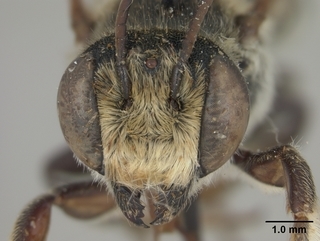
Smithsonian Institution, Entomology Department · 9
Megachile deflexa, face |
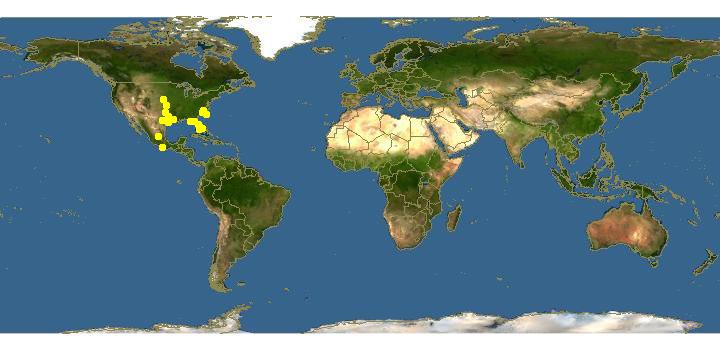
Click on map for details about points.
|
80x5 -
240x3 -
240x4 -
320x1 -
320x2 -
320x3 -
640x1 -
640x2
Set display option above.
Click on
images to enlarge. |
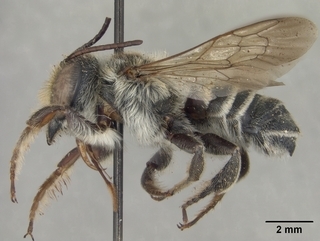
Smithsonian Institution, Entomology Department · 9
Megachile deflexa, side |
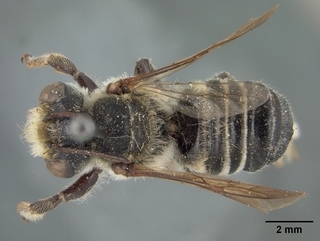
Smithsonian Institution, Entomology Department · 9
Megachile deflexa, top |
|
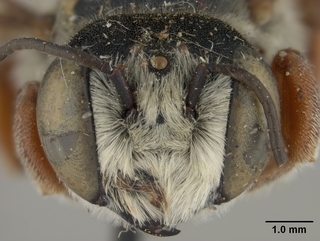
Smithsonian Institution, Entomology Department · 9
Megachile deflexa, male, face |
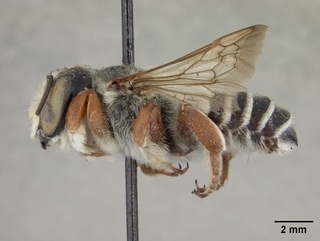
Smithsonian Institution, Entomology Department · 9
Megachile deflexa, male, side |
|
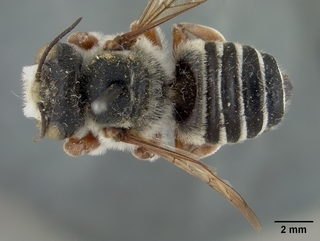
Smithsonian Institution, Entomology Department · 9
Megachile deflexa, male, top |
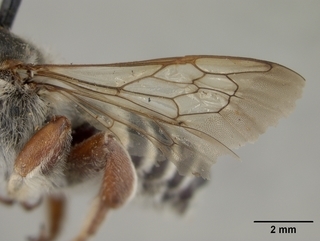
Smithsonian Institution, Entomology Department · 9
Megachile deflexa, male, wing |
|
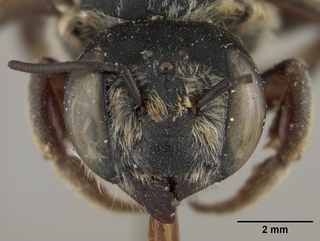
Smithsonian Institution, Entomology Department · 9
Megachile deflexa, female, face |
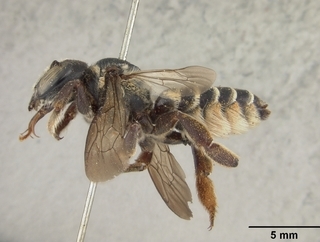
Smithsonian Institution, Entomology Department · 9
Megachile deflexa, female, side |
|
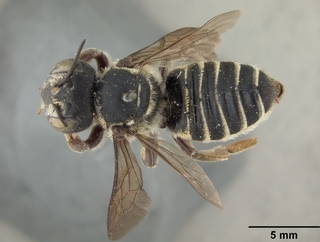
Smithsonian Institution, Entomology Department · 9
Megachile deflexa, female, top |
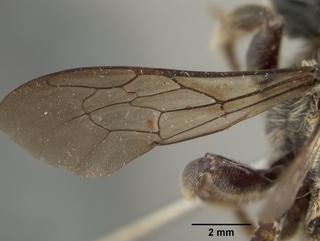
Smithsonian Institution, Entomology Department · 9
Megachile deflexa, female, wing |
|
Overview |
Reprinted with permission from: Mitchell, T.B. 1962 Bees of the Eastern United States. North Carolina Agricultural Experiment Station Technical Bulletin No. 152.
FEMALE—Length 15-17 mm.; black, tegulae more brownish, legs black, spurs yellowish; eyes subparallel; clypeal margin narrowly produced and slightly incurved medially, with a small, median denticle; mandibles 4-dentate, a bevelled edge between 3rd and 4th teeth; lateral ocelli much nearer eyes than to margin of vertex; cheeks subequal to eyes in width; vertex somewhat shining between deep, distinct, rather fine and close punctures, these becoming slightly separated laterally, punctures of cheeks close and fine above, becoming somewhat coarser but still quite close below; face below ocelli quite densely rugoso-punctate, finely so between antennae and eyes, clypeus with quite coarse and deep punctures medially where they are slightly separated, but becoming fine and densely crowded on each side; pubescence whitish on face and cheeks, rather copious but short around antennae and at sides of face, somewhat elongate but rather thin on cheeks below, becoming short and thin above, very short but erect over entire vertex; pubescence whitish or cream color on thorax laterally and posteriorly, dorsum of thorax largely covered with extremely short, erect, fuscous or blackish pubescence, the scutello-mesothoracic suture with a line of pale tomentum; scutum quite deeply and distinctly punctate throughout, punctures somewhat coarser and more distinctly separated medially, becoming densely crowded laterally and posteriorly, scutellum somewhat more finely and very densely punctate throughout, punctures of axillae slightly more coarse, deep and distinct; pleura somewhat shining, punctures rather shallow but quite distinct, to some slight degree separated but becoming densely crowded above; lateral faces of propodeum quite smooth but rather dull, not distinctly punctate, posterior face with rather close, minute and indistinct punctures; mid and hind basitarsi about equal to their tibiae in breadth, hind pair equalling their tibiae in length also; front tarsi relatively slender; tegulae minutely and closely punctate; wings subhyaline, becoming rather deeply infuscated apically, veins brownish-testaceous; abdominal terga 2-4 rather deeply grooved across base, basal margin of grooves distinct but hardly carinate, terga 15 with complete, dense, yellowish, apical fasciae, apical margins rather sharply depressed laterally but only obscurely so medially on the more basal terga; tergum 1 with rather elongate, thin, yellowish pubescence medially, with a dense, yellowish patch of tomentum at each extreme side, discal pubescence of following terga very short, erect and fuscous; tergal punctures uniformly fine and quite close, becoming slightly coarser and more distinctly separated laterally on the more apical terga, 6 about straight, with very short, suberect, dark hairs visible iu profile, broadly rounded apically in dorsal view, surface very densely and finely punctate, punctures obscured toward apex by rather dense, appressed, pale yellowish tomentum; sternum 6 well covered with dark scopal hairs, becoming rather thin toward the apical fringe of very short dark bristles; scopa yellowish-white, the more basal sterna very closely and finely punctate, punctures becoming more coarse, deep and distinct on the more apical sterna, apical margins
narrowly depressed and hyaline; sternal fasciae not evident.
MALE—Length 15 mm.; black, tegulae more brownish-testaceous, legs black, spurs yellow; eyes very slightly convergent below; apical margin of clypeus with a rather narrow, median, slightly incurved area, with a minute, median tubercie; mandibles 3-dentate or sometimes obscurely 4-dentate (fig. 47), with a rather narrow and acute, sub-basal, inferior process; apical segment of flagellum slender and elongate; lateral ocelli much nearer eyes than to margin of vertex; cheeks sub- equal to eyes in width, not angulate below, but this area obscured by dense, elongate pubescence; vertex shining, punctures deep and distinct, close except at extreme sides where they are well separated, becoming close and fine on cheeks; face below anterior ocellus rather coarsely rugoso-punctate, becoming very finely so laterally and below, beneath dense pubescence; pubescence very dense, yellowish-white around antennae and over face below, snowy white, dense and elongate on cheeks below, becoming quite short and thin above, vertex with very short, erect but rather thin, fuscous pubescence; thorax rather densely white pubescent laterally and posteriorly, but short and fuscous on scutum, with some pale, erect hairs anteriorly and a pair of very obscure lines of tomentum, the scutellomesothoracic suture narrowly pale tomentose; pubescence of scutellum and axillae relatively pale and elongate; pleura dull, punctures quite densely crowded below, relatively distinct but still close above: lateral faces of propodeum rather smooth but dull, punctures obscure, posterior face somewhat more shining, punctures rather close but minute and rather vague; punctures of scutum rather fine and close, densely crowded in large part, those of scutellum fine and crowded, axillae with rather coarse and distinctly separated punctures; front coxal spines short, not much longer than they are broad at base, narrowly rounded apically, densely long white pubescent posteriorly, front coxae with considerable white pubescence but without patches of ferruginous bristles; mid tibial spurs well developed; front tarsi slender and simple, not at all dilated nor grooved, but with a rather dense, posterior fringe of rather short, snowy-white hairs; mid basitarsi rather short and narrow, with a quite conspicuous posterior fringe of elongate, white hairs; mid tibial spurs well developed; hind basitarsi short and slender, fringed anteriorly; tegulae minutely but quite closely and distinctly punctate; wings subhyaline, faintly infuscated apically, veins more brownish; abdominal terga 2-5 rather deeply grooved across base, •basal margins of grooves subcarinate on the more basal terga, but becoming quite sharply carinate on 4-5; terga 1-5 with complete, narrow, dense, apical, yellowish fasciae, apical margins rather deeply depressed laterally, but only obscurely so medially on the more basal terga; tergum 1 with elongate, pale yellowish pubescence, this becoming very dense at each extreme side, discal pubescence of the following terga largely dark and very short, but with some pale hairs across base of 2 and 3; punctures rather uniformly fine and close, becoming somewhat more irregular, distinct and more distant on tergum 5, 6 somewhat shining, punctures rather shallow but distinct and close, carina subtriangular, with a more or less rounded apex, sides relatively straight, with no median emargination, median teeth of apical margin carinate, slightly nearer the short but acute lateral teeth than to each other; tergum 7 almost entirely hidden, not produced medially; sterna 1-4 exposed, punctures quite deep and distinct, well separated and rather coarse except on sternum 1; lateral pubescence plates of sternum 5 poorly defined, setose area broad and expansive, setae rather sparse and minute (fig. 48); sternum 6 with well separated, lateral setose areas, the setae sparse and short, apical lobe very broad, lateral angles acute; gonocoxites narrowed above base, slightly dilated and sinuate above, compressed at tips (fig. 49).
DISTRIBUTION—North Carolina, along the coast to Florida, west to Texas, and north to Nebraska, April (in Florida) to September.
FLOWER RECORDS—Bidens, Clethra, Erigeron, Phaseolus and Rhus.
|
|
|
Names | |
|
|
| Supported by | |
Updated: 2024-04-29 16:17:52 gmt
|